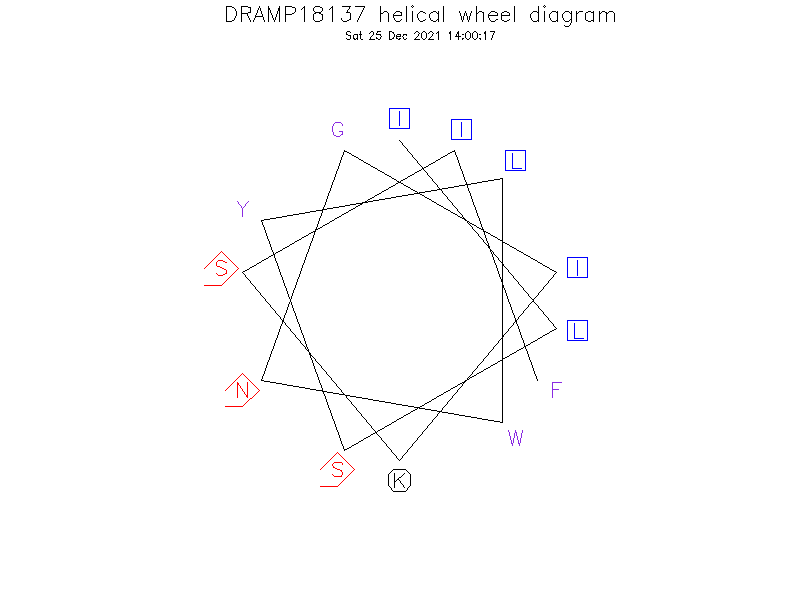General Information
-
DRAMP ID
- DRAMP18137
-
Peptide Name
- Peptide Hp1239 (Non-disulfide-bridged peptide 5; NDBP-5)
-
Source
- Heterometrus petersii (Asian forest scorpion)
-
Family
- Belongs to the scorpion NDBP 5 family
-
Gene
- Not found
-
Sequence
- ILSYLWNGIKSIF
-
Sequence Length
- 13
-
UniProt Entry
- P0DME8
-
Protein Existence
- Transcript level
Activity Information
-
Biological Activity
- Antimicrobial, Antibacterial, Antiviral
-
Target Organism
- CC50=26.15 ± 1.91 μM; HC50= 33.32 ± 0.96 μM; EC50=0.41 ± 0.06 μM
-
Hemolytic Activity
-
- No hemolysis information or data found in the reference(s) presented in this entry
-
Cytotoxicity
-
- Not included yet
-
Binding Target
- Not found
Structure Information
-
Linear/Cyclic
- Not included yet
-
N-terminal Modification
- Not included yet
-
C-terminal Modification
- Not included yet
-
Nonterminal Modifications and Unusual Amino Acids
- Not included yet
-
Stereochemistry
- Not included yet
-
Structure
- Not found
-
Structure Description
- Not found
-
Helical Wheel Diagram
-
PDB ID
- None
-
Predicted Structure
- There is no predicted structure for DRAMP18137.
Physicochemical Information
-
Formula
- C348H562N82O103S3
Absent Amino Acids
- CHP
Common Amino Acids
- L
Mass
- 1553.86
PI
- 8.59
Basic Residues
- 6
Acidic Residues
- 10
Hydrophobic Residues
- 29
Net Charge
- -4
-
Boman Index
- -5052
Hydrophobicity
- 0.36
Aliphatic Index
- 128.06
Half Life
-
- Mammalian:30 hour
- Yeast:>20 hour
- E.coli:>10 hour
Extinction Coefficient Cystines
- 6990
Absorbance 280nm
- 105.91
Polar Residues
- 16
DRAMP18137
Comments Information
Function
- Amphipathic peptide with antibacterial activities (By similarity). Shows antiviral activities against the herpes simplex virus type-1. It potently inhibits the initial infection by provoking the rupture of viral envelop and the dissociation of proteins from the virions (EC (50) is 0.41 μM). It also effectively inhibits viral attachment (EC (50) is 5.73 μM), viral entry (EC (50) is 4.32 μM) and viral proliferation after infection (EC (50) is 8.41 μM). Morever, it enters mammalian tested cells (Vero) and reduces the intracellular infectivity.
Literature Information
- ·Literature 1
-
Title
- Molecular diversity of toxic components from the scorpionHeterometrus petersii venom revealed by proteomic and transcriptomeanalysiS.
-
Pubmed ID
- 20443192
-
Reference
- Proteomics 10:2471-2485 (2010).
-
Author
- Ma Y., Zhao Y., Zhao R., Zhang W., He Y., Wu Y., Cao Z., Guo L., Li W.
- ·Literature 2
-
Title
- Inhibitory activity and mechanism of two scorpion venom peptidesagainst herpes simplex virus type 1.
-
Pubmed ID
- 24315793
-
Reference
- Antiviral ReS. 102:1-10 (2014).
-
Author
- Hong W., Li T., Song Y., Zhang R., Zeng Z., Han S. , Zhang X., Wu Y., Li W., Cao Z.

